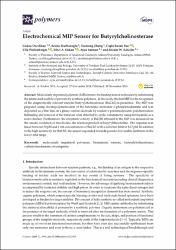| dc.contributor.author | Özçelikay, Göksu | |
| dc.contributor.author | Kurbanoğlu, Sevinç | |
| dc.contributor.author | Zhang, Xiaorong | |
| dc.contributor.author | Söz, Çağla | |
| dc.contributor.author | Wollenberger, Ulla | |
| dc.contributor.author | Özkan, Sibel Ayşıl | |
| dc.contributor.author | Scheller, Frieder W. | |
| dc.date.accessioned | 2021-01-08T21:51:21Z | |
| dc.date.available | 2021-01-08T21:51:21Z | |
| dc.date.issued | 2019 | |
| dc.identifier.issn | 2073-4360 | |
| dc.identifier.uri | http://doi.org/10.3390/polym11121970 | |
| dc.identifier.uri | https://hdl.handle.net/20.500.12846/175 | |
| dc.description | Soz, Cagla/0000-0003-3942-070X; Wollenberger, Ulla/0000-0002-7088-8928 | en_US |
| dc.description | WOS:000507624500063 | en_US |
| dc.description | PubMed: 31801184 | en_US |
| dc.description.abstract | Molecularly imprinted polymers (MIPs) mimic the binding sites of antibodies by substituting the amino acid-scaffold of proteins by synthetic polymers. In this work, the first MIP for the recognition of the diagnostically relevant enzyme butyrylcholinesterase (BuChE) is presented. The MIP was prepared using electropolymerization of the functional monomer o-phenylenediamine and was deposited as a thin film on a glassy carbon electrode by oxidative potentiodynamic polymerization. Rebinding and removal of the template were detected by cyclic voltammetry using ferricyanide as a redox marker. Furthermore, the enzymatic activity of BuChE rebound to the MIP was measured via the anodic oxidation of thiocholine, the reaction product of butyrylthiocholine. The response was linear between 50 pM and 2 nM concentrations of BuChE with a detection limit of 14.7 pM. In addition to the high sensitivity for BuChE, the sensor responded towards pseudo-irreversible inhibitors in the lower mM range. | en_US |
| dc.description.sponsorship | ERA-Chemistry (2014) [61133]; Deutsche Forschungsgemeinschaft (DFG, German Research Foundation) under Germany's Excellence StrategyGerman Research Foundation (DFG) [EXC 2008/1, 390540038]; Ankara University Erasmus Program; Ankara University UBED ProgramAnkara University | en_US |
| dc.description.sponsorship | This work was supported by ERA-Chemistry (2014, 61133) and partially funded by the Deutsche Forschungsgemeinschaft (DFG, German Research Foundation) under Germany's Excellence Strategy - EXC 2008/1 (UniSysCat) - 390540038 [Gefordert durch die Deutsche Forschungsgemeinschaft (DFG) im Rahmen der Exzellenzstrategie des Bundes und der Lander - EXC 2008/1 (UniSysCat) -390540038]. G.O., S.K. and S.A.O. gratefully acknowledge financial support from Ankara University Erasmus and UBED Programs. | en_US |
| dc.language.iso | eng | en_US |
| dc.publisher | Mdpi | en_US |
| dc.rights | info:eu-repo/semantics/openAccess | en_US |
| dc.subject | Molecularly Imprinted Polymers | en_US |
| dc.subject | Biomimetic Sensors | en_US |
| dc.subject | Butyrylcholinesterase | en_US |
| dc.subject | O-Phenylenediamine | en_US |
| dc.subject | Rivastigmine | en_US |
| dc.title | Electrochemical MIP sensor for butyrylcholinesterase | en_US |
| dc.type | article | en_US |
| dc.relation.journal | Polymers | en_US |
| dc.identifier.volume | 11 | en_US |
| dc.identifier.issue | 12 | en_US |
| dc.relation.publicationcategory | Makale - Uluslararası Hakemli Dergi - Kurum Öğretim Elemanı | en_US |
| dc.contributor.department | TAÜ, Fen Fakültesi, Malzeme Bilimi ve Teknolojileri Bölümü | en_US |
| dc.contributor.institutionauthor | Söz, Çağla | |
| dc.identifier.doi | 10.3390/polym11121970 | |
| dc.identifier.wosquality | Q1 | en_US |
| dc.identifier.scopusquality | Q1 | en_US |
| dc.identifier.wos | WOS:000507624500063 | en_US |

















